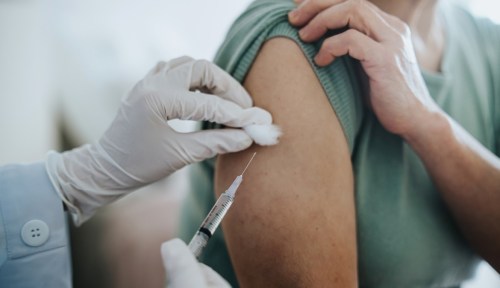Medically defined, infertility is the inability to become pregnant after one year or longer of unprotected sex. Emotionally, it’s a nightmare for any person who has ever dreamed of becoming a parent. It’s a medical condition that many suffer in silence, treat in secret, and pay for out of pocket. And the worst part is: Not everyone has equal access to the treatments that offer hope for couples struggling to conceive.
Experts in This Article
Fahimeh Sason, MD, is the founding OB/GYN at Kindbody, a fertility treatment clinic in New York, Los Angeles, and San Francisco.
Michael A. Thomas, MD, is chief of the division of reproductive endocrinology and infertility at the University of Cincinnati College of Medicine.
Rebecca Flick is the chief external affairs officer at Resolve: The National Infertility Association.
Will Kiltz is the director of marketing and communications at CNY Fertility, a network of fertility clinics in New York, Georgia, and Colorado.
If you or your partner have trouble getting pregnant or sustaining a pregnancy—as one in eight couples do—you are in for a hell of a fight, regardless of your race. But if you’re Black, Latinx, or Native American, you are in for a war. “You cannot downplay the fairly substantial evidence that suggests minorities have it worse than their white counterparts,” says Will Kiltz, the communications director at CNY Fertility, a clinic in Syracuse, New York.
Here are the facts: Twelve percent of U.S. women used fertility services between 2006 and 2010, according to data collected by the National Survey of Family Growth. But white women were almost twice as likely as Black or Latinx women to have done so—15 percent of non-Hispanic white women used medical help to get pregnant, while only 8 percent of (non-Hispanic) Black women and 7.6 percent of Hispanic women reported the same. So why the racial disparities in care? The reasons are complex, and experts say there is a long road ahead to positive change.
Why racial disparities in fertility treatment exist
Following a preliminary visit to the OB/GYN, the journey to parenthood for many heterosexual couples begins at home. Depending on the age and overall physical health of both parties, experts say that following six months to a year of contraceptive-free sex, a pregnancy should result. If a pregnancy is not achieved in that timeframe, the standard practice is for an OB/GYN to refer the couple to a fertility specialist.
However, some Black, Indigenous, and people of color (BIPOC) say their doctors made them wait much longer to get that all-important referral. “My husband and I have been trying for 21 years to have this baby,” says Racheal Martinez, now age 40. When Martinez was 20, she was newly married and living on a military base with her husband. She shared with her OB/GYN that she wanted to have a child but was having trouble conceiving. She asked her provider for a referral to a fertility specialist. She says her doctor refused and told her she was “too young” for treatment and that having a baby with her husband would make her “another statistic.” (Martinez is Black and her husband Roberto is Mexican American.)
It took another six years before a physician provided Martinez with a referral to a fertility specialist. In that time, and the years that followed, Racheal and her husband experienced 22 miscarriages, a diagnosis of polycystic ovarian syndrome (a hormone disorder that can lead to infertility if untreated), a diagnosis of recurrent miscarriages, and a diagnosis of hypothyroidism (a hormone condition that can also negatively affect fertility).
“There are some studies that show that patients of color are referred to fertility specialists a little later than white patients,” says Michael Thomas, MD, chief of the division of reproductive endocrinology and infertility at the University of Cincinnati College of Medicine. He says delays in treatment for patients of color—like what Martinez faced—occur for a variety of reasons.
One small survey of 50 Black women found that 26 percent of them believed that their encounters with medical professionals had been influenced by gender, race, and/or class discrimination, and some reported that their doctors made assumptions about their inability to pay for services based.
Martinez was young when she approached her physician for a referral, and perhaps the provider assumed time was on her side. But it’s also possible that her doctor was making assumptions about her fertility based on her race. In the case of Black patients like Martinez, there is data to support this. Although Black women are at a higher risk for fibroid tumors and health issues such as diabetes and hypothyroidism that can lead to an increased risk of fertility issues, only 16 percent of doctors correctly identified Black women as the racial group most at risk for infertility, according to a 2019 survey of 150 family doctors and OB/GYNS conducted by Fertility IQ.
“It was horrible. [The fertility doctor] had his arms and legs crossed the whole time. You could tell he thought we couldn’t afford [treatment] and wondered what we were doing there.” —Nicole Vaughn, 34, fertility patient
When doctors make assumptions about their patients, the results can be costly. A person’s fertility declines with age and a two- or three-year delay in seeking infertility treatment can decrease the chances of a successful pregnancy. “OB/GYNs have to treat all patients the same,” says Dr. Thomas. “They have to understand that if a patient needs a fertility expert, it’s important to send them early rather than later.”
Once a patient gets their foot in the door of the fertility specialist’s office, it’s not an instantaneous lassoing of the stork. Fertility treatment comes with a price tag, and for many people, this cost is the biggest obstacle of all. According to the National Conference of State Legislatures (NCSL), one cycle of IVF costs on average between $12,000 to $17,000. (That doesn’t include the cost of medication required for IVF, which can bring the total cost closer to $25,000 for one cycle.) And in the majority of states, infertility treatment is not covered by insurance (only 19 states legally require some level of fertility coverage for residents). This leaves patients without the means to pay the bill the tough decision between walking away or going into debt.
This was the case for Nicole and Vaughn Hill, 34 and 33 respectively, educators from Texas. The couple (both Black) began the process of trying to start a family about three years ago. Nicole had long experienced irregular periods, which her OB/GYN told her was “normal.” When she and Vaughn struggled to conceive, Nicole’s provider prescribed a fertility drug called Clomid to help boost their chances. After four failed cycles on the drug, Nicole’s doctor referred the couple to a reproductive endocrinologist.
“Dr. Smug,” recalls Nicole. “It was horrible. He had his arms and legs crossed the whole time. You could tell he thought we couldn’t afford [treatment] and wondered what we were doing there. He didn’t go into a lot of detail about any of the treatment options. I felt more confused than anything. Worst experience I could have ever had,” says Nicole.
Like many people experiencing infertility, Nicole and Vaughn were not rich. “So that we could afford treatment, we both taught summer school, and I also received a promotion while we were going through the process,” says Vaughn. In the end (after finding a new fertility doctor), Nicole and Vaughn spent approximately $25,000 for two IVF procedures and four embryo transfers. It was a hefty price, but they say worth every penny for just one giggle from their daughter Amaya, who is now eight months old.
While the Hills found a way, many others are not as fortunate. According to the U.S. Census Bureau, the median household income for non-Hispanic white households is $76,057; for Black households, $45,438; for Hispanic households of any race, it’s $56,113—income disparities largely due to systemic racism that historically has made accessing wealth, loans, and equitable pay more difficult for many BIPOC communities. To afford treatment, many families must consider various financing options such as refinancing their homes, working second or third jobs, changing jobs to work for an employer who offers fertility benefits, moving to a state with mandated coverage, and/or applying for loans.
And even if a couple has the means to undergo infertility treatment, that doesn’t mean they feel comfortable doing so. Many patients who have trouble sustaining a pregnancy keep their struggles private. While the stigma of infertility is nearly universal, it can be compounded by social and religious beliefs. “There are a lot of conversations in the Black community about what we ‘don’t’ do,” Regina Townsend, founder of online fertility support group The Broken Brown Egg, previously told Well+Good. “We don’t go to therapy, we pray. We don’t ‘give our kids away’ or adopt. Phrases like that are really damaging. It’s the wrong story to tell ourselves,” she said. To her point, these types of beliefs may cause a couple to reject, or in some cases refuse to discuss, medical options available.
Beyond price, the fertility industry at large has also not made itself particularly available to BIPOC patients. The industry relies on physician referrals and marketing—promotional materials with testimonials from patients, websites, and social media—to bring in new patients. But many of these efforts do not include or reach potential BIPOC patients. In one review of the websites for 372 fertility clinics, 63 percent of those sites only featured pictures of white babies, according to a paper published in the Indiana Law Journal. The lack of diverse imagery hammers home the concept that fertility treatments are not available for all people, just certain people.
How to start combating these disparities
The racial disparities in fertility treatment are not going to be solved overnight. “This has been a problem for a long time, and we have to address it,” says Rebecca Flick, the chief external affairs officer for Resolve: The National Infertility Association. Fortunately, things are starting to change. The fertility startup Kindbody—which aims to be a more inclusive company through its marketing, promotional materials, and staff—says 44 percent of its patients are people of color, suggesting that the message is being heard and received. According to Kindbody founding physician Fahimeh Sasan, MD, inclusivity is imperative for progress in the industry. “The key is to educate people about fertility, to educate them about facts,” she says. “We can’t improve access if people don’t know about the process.”
Advocacy and educational organizations such as The Broken Brown Egg, Sister Girl Foundation, and the Cade Foundation are also helping to improve the situation by offering resources, support, and opportunities to women of color dealing with infertility—resources that can help break stigma and help BIPOC patients be better advocates for their care. And in 2020, Kindbody partnered with Fertility for Colored Girls, an organization dedicated to raising awareness surrounding the issues of fertility and race, to award a collective $50,000 to four BIPOC women looking for financial assistance for fertility treatment. (After receiving more than 300 applications, Dr. Sasan says the company is open to extending the program due to the response.)
Making fertility treatment more affordable will also help. Both the Martinezes and Vaughns ended up getting pregnant with the help of CNY Fertility. “Our mission has always been to make fertility care accessible to everyone, including the traditionally underserved,” says Kiltz. An IVF cycle at the clinic costs, on average, $3,900, a price that makes its services more accessible to a wider group of people. “Our patient population is approximately 40 percent minority populations, 20 percent of whom are African American,” he adds.
CNY Fertility and Kindbody have also instituted open-door policies that allow patients to schedule a consultation without a referral, which can help mitigate some of the delays experienced by many BIPOC patients. “The first person to know something is wrong with their body is the patient. So, let them go straight to the experts,” says Kiltz. Although CNY Fertility also accepts referrals from OB/GYNs, more than 50 percent of their patients are self-referred.
Doctors who specialize in reproductive medicine are also working to improve access to their care for all patients. The American Society of Reproductive Medicine (ASRM) recently created a diversity, equity, and inclusion task force (Dr. Thomas is the chair). One of its goals is to recruit more physicians of color into the field. “When I started back in the ’80s, there were fewer than 10 reproductive endocrinologists of color. It’s increased since then, but not substantially,” says Dr. Thomas. “I think that by slowly increasing the number of physicians of color, we will have a better understanding of what African American women go through.” And that, he says, “would be helpful to all patients.”
While the work is underway, patients who have been through infertility say there is still much to be done—and you can’t rely on the system to do it for you. “You have to advocate,” says Martinez. “You have to do a lot of research. You may need a second or third opinion because some doctors are going to be biased, but you have to do what you have to do and be smart.” The experts are listening. It’s how they act from here that will make the difference.
If you love free workouts, discounts for must-have wellness brands, and exclusive Well+Good content, sign up for Well+, our online community of wellness insiders, to unlock your rewards instantly.
Sign Up for Our Daily Newsletter
Get all the latest in wellness, trends, food, fitness, beauty, and more delivered right to your inbox.
Got it, you've been added to our email list.











